GAP – Harvest Management of Black Pepper
Importance of GAP
Good Agricultural Practices or GAP are “practices that need to be applied on farms to ensure food safety during pre-production, production, harvest and post-harvest. In many cases such practices also help protect the environment and safety of workers”. They are a collection of principles to apply for farm production and post-production processes resulting in safe and healthy food and non-agricultural products while taking into account economic, social and environmental sustainability. Their purpose varies from fulfillment of trade and government regulatory requirements, in particular with regard to food safety and quality, to more specific requirements of specialty or niche markets. In addition to facilitation of market access, reduction in noncompliance risks regarding pesticide residues and microbial and other contaminant hazards may be achieved. GAP schemes are predominantly consumer driven and incorporate trace-ability requirements as an important part of their food safety measures.
Black pepper Harvesting
Black pepper takes about 7-8 months after flowering to reach full maturity. In India the crop is
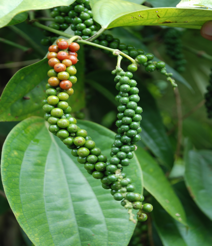
harvested during December –January in plains and January-April in the high ranges of Western Ghats. It is important to harvest pepper at the proper stage of maturity in order to achieve a dried product of good colour and appearance. Harvest starts when one or two berries turn yellow. The spikes are nipped of by hand and collected in bags.
Normally, single pole bamboo ladder is used as a support for harvesting.
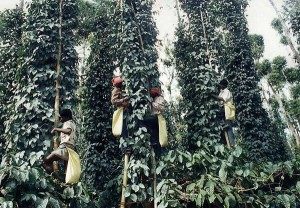
If the berries are allowed to over ripe, there is heavy loss due to berry drop and damage by birds. Harvested spikes are generally collected in clean gunny bags. Spikes which are fallen on to the ground may be collected separately, cleaned and then pooled to the general lot. Recent advances in product diversification have necessitated harvesting of the berries at different stages of maturity. The level of maturity required at harvest for processing into different pepper products is given below.
| Product | Stage of maturity at harvest |
| Canned pepper | 4-5 months |
| Dehydrated green pepper | 10-15 days before maturity |
| Oleoresin and essential oil | 15-20 days before maturity |
| Black pepper | Fully mature and 1-2 berries start turning from yellow to red in each spike |
| Pepper powder | Fully mature |
| White pepper | Fully ripe |
Post harvest processing
Post harvest processing operations followed for black pepper involves threshing, blanching, drying, cleaning, grading and packaging. During processing care should be taken to maintain the quality at each step of operation. The berries are separated from the spikes manually on a clean cement floor or by using a manually operated or motorized thresher and the stalks separated out from the berries.
Threshing
Threshers with capacities varying from 50 kg/h to 2500 kg/h are available which can thresh quickly and provide clean product.
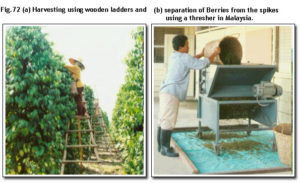
For easy operation, harvested spikes may be kept in a bag for 12 to 24 hours or heaped and kept covered overnight. It is ideal to grade green pepper using a wire mesh to remove light berries, pin heads and small berries.
Blanching
The quality of the black pepper can be improved by a simple treatment of dipping the mature berries taken in perforated vessel in boiling water for a minute before drying.
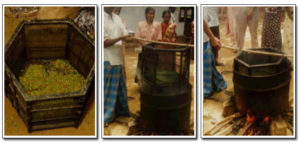
This processing technique has several advantages:
- Uniform coloured black pepper is obtained after drying.
- Reduces the microbial load.
- Pepper can be dried in 3-4 days as against 5-6 days required when following the traditional practice
- Removes the extraneous impurities like dust from the berries. Blanching reduces microbial load, washes off dust particles, and helps in drying pepper faster. Blanched, dried black pepper has a glossy appearance and a better, more uniform colour.
In Sri Lanka, pepper is blanched by steeping berries in hot water, of about 90o C, for 2-3 minutes
Cautions to be taken while Blanching
Blanching has to be done carefully, adhering to the time limit, as over-blanching may cause quality problems including loss of essential oils.
Drying
Pepper has moisture content of 65% to 70% at harvest, which should be brought to safer levels of 10% by adequate drying. The green colour of matured pepper is due to the presence of chlorophyll pigment. During drying, enzymatic browning sets in and the phenolic compounds are oxidized by atmospheric oxygen under the catalytic influence of the enzyme phenolase and eventually turn black.
Sun drying is the conventional method followed for drying of black pepper.Sun drying is done by spreading berries, (if blanched, after draining off surface water), thinly on a raised cemented drying yard or on bamboo mats or fine fishnets or shade cloth placed on a platform.
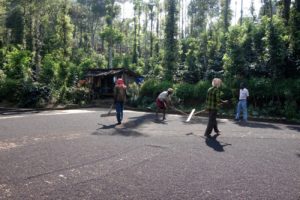 The despiked berries are spread on concrete floor and dried under sun for 3-5 days to bring the moisture content below 10%.
The despiked berries are spread on concrete floor and dried under sun for 3-5 days to bring the moisture content below 10%.
Dried black pepper with high moisture content (>12%) is susceptible to fungal attack. Mycotoxins produced by the fungal attack render the pepper unfit for human consumption. In order to achieve a quality dry product, pepper berries are spread on clean dry concrete floor / bamboo mats/ PVC sheets and dried in the sun for a period of 4 – 6 days. The average dry recovery varies between 33-37% depending on the varieties and cultivars. Mechanical driers developed by various agencies are also used to dry black pepper. Models of varying capacities operated either electrically or by burning agricultural wastes are available for drying of black pepper by maintaining temperature below 550C.
Methods & Care taken while drying
- Solar, fuel powered or electrical dryers may be used for fast drying.
- Bamboo mats used for drying pepper may be coated with paper and fenugreek paste and dried in the sun for longer life.
- Both low density and high density polythene sheets may be used for drying pepper in the sun.Polythene sheets have a few advantages compared to other materials. If the sheets are black, they absorb more heat and reduce drying time.
- Sheets may be used to cover pepper during the night and the pepper may be left outside if the place is secure. If it rains unexpectedly, the pepper can be quickly gathered to the middle of the sheets, which can then be folded. When not in use, sheets can be folded and stored conveniently.
- Care should be taken however, when using polythene sheets as the pepper may “sweat” due to condensation, and mould growth can occur if there is inadequate air flow or the pepper is not turned frequently.
Cleaning and Grading
The threshed and dried black pepper has extraneous matter like spent spikes, pinheads, stones, soil particles etc. mixed with it. Cleaning and grading are basic operations that enhance the value of the produce and help to get higher returns. Cleaning on a small scale is done by winnowing and hand picking which removes most of the impurities. Such units consist of a fan/ blower and a feeding assembly. The fan is placed at the rear end of the hopper. Cleaning is achieved by feeding the material through the hopper into a stream of air blowing in perpendicular direction. The lighter fractions (dust, immature berries, pin heads and spent spikes) are blown away. Grading of black pepper is done by using sieves and shifting black pepper into different grades based on size.
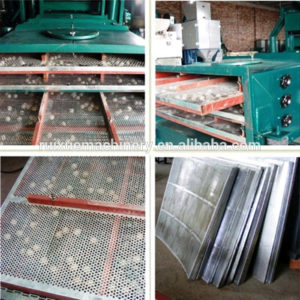
The major grades of black pepper are
- Tellicherry Garbled Special Extra Bold (TGSEB)(4.8 mm);
- Tellicherry Garbled Extra Bold (TGEB) (4.2 mm);
- Tellicherry Garbled (TG) (4.0 mm);
- Malabar Garbled (MG grades 1 and 2) and Malabar Ungarbled (MUG grades 1 and 2).
Packaging
Organically grown black pepper should be packaged separately and labeled. Mixing different types of pepper is not good from a commercial. Eco friendly packaging materials such as clean gunny bags or paper bags may be adopted and the use of polythene bags may be minimized. Recyclable/ reusable packaging materials shall be used wherever possible.
Storage
Black pepper is hygroscopic in nature and absorption of moisture from air, during rainy season when there is high humidity may result in mould and insect infestation. Before storage it is to be dried to less than 10 per cent moisture. The graded produce is bulk packed separately in multi layer paper bags or woven polypropylene bags provided with food grade liners or in jute bags. The bags are arranged one over the other on wooden pallets after laying polypropylene sheets on the floor.
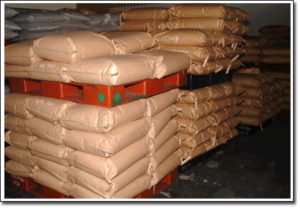 Doors, windows and ventilators of the store should always be kept closed at night and during wet weather to prevent dampness and condensation. Entry of animals, rodents and other pests to the store should be completely prevented. If necessary, recommended rodent repellents may be used in the store. Pest control practices should be followed systematically. Permitted pesticides and chemical fumigants may be applied, provided the dosages are stringently followed. Any fumigation treatment should be administered only be a competent expert.
Doors, windows and ventilators of the store should always be kept closed at night and during wet weather to prevent dampness and condensation. Entry of animals, rodents and other pests to the store should be completely prevented. If necessary, recommended rodent repellents may be used in the store. Pest control practices should be followed systematically. Permitted pesticides and chemical fumigants may be applied, provided the dosages are stringently followed. Any fumigation treatment should be administered only be a competent expert.
Hygiene requirements
Persons engaged in threshing, sifting, sun drying etc. should clean their hands and feet with soap and water before they begin work. Baskets and other containers used in processing and storage should always be kept clean. For sifting pepper, only clean bamboo trays should be used. Premises should be dry and stores should be clean and hygienic. Borders of the drying yard should be protected to keep out birds, domestic animals, rodents etc. Gutters and waste water outlets connected to the drying yard or white pepper processing area should always be maintained in a clean condition.
References:
[1]Harvesting and Postharvest Management guide by ipcnet.org
[2]Black pepper – Extension pamphlet November 2015 by ICAR-Indian Institute of Spices Research, Kozhikode, Kerala
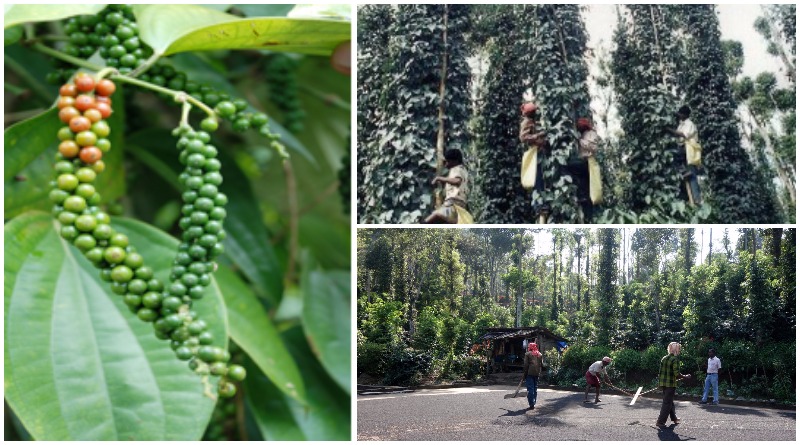
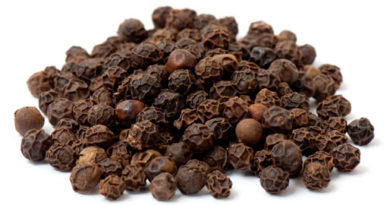
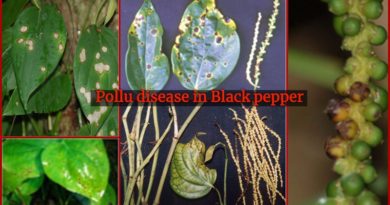
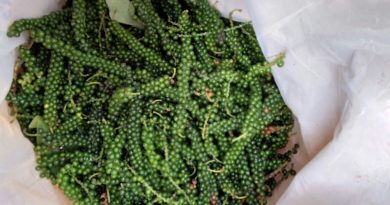
Pingback: GAP - Preparation of Black and White pepper - Kirehalli